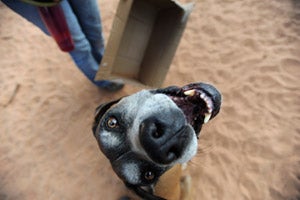Brain games for dogs

It's widely known that brain games can improve people's memory and cognition and potentially help ward off age-related diseases, such as Alzheimer's disease and dementia. But it's perhaps a lesser-known fact that such enrichment can benefit dogs as well.
What a dog can to do with a box
 Take Chester, for example. This boxer/mastiff mix once lived as a stray and came to the Sanctuary with poor manners. But the seven-year-old dog is really smart, and his caregivers soon began doing enrichment training with him. His favorite game is one that Best Friends trainer Tamara Dormer calls "101 things you can do with a box." In this exercise, boxes of various sizes are set up around Chester's octagon, and treats and a clicker are used to reward him for interacting with them. For example, he can look at a box, sniff it, approach it, or put his foot on it and receive positive reinforcement for participating in the game. It's an activity that Chester particularly enjoys, and the brain work has helped him calm down and be a bit more polite.
Take Chester, for example. This boxer/mastiff mix once lived as a stray and came to the Sanctuary with poor manners. But the seven-year-old dog is really smart, and his caregivers soon began doing enrichment training with him. His favorite game is one that Best Friends trainer Tamara Dormer calls "101 things you can do with a box." In this exercise, boxes of various sizes are set up around Chester's octagon, and treats and a clicker are used to reward him for interacting with them. For example, he can look at a box, sniff it, approach it, or put his foot on it and receive positive reinforcement for participating in the game. It's an activity that Chester particularly enjoys, and the brain work has helped him calm down and be a bit more polite.
But it's not just the older guys who need mental stimulation. Enrichment is something that our trainers and caregivers do all across the Sanctuary and at our Pet Adoption and Spay/Neuter Center in Los Angeles. "Humans don't realize how much enrichment we provide ourselves every day," Tamara explains. "We can take walks, read books, watch (educational) TV, but our dogs rely on us to keep them out of a rut." Like humans, dogs get just as tired from mental stimulation as they do physical exercise, so it's a good way to deal with energetic dogs, especially when the weather is bad and you can't go for a run or a walk. It's also good for dogs who live as only pets, or whose people work long hours.
Puzzles and pops for dogs
 Bored dogs often make unwise choices when trying to entertain themselves; some can even become destructive. Whereas in the wild dogs spend about 90 percent of their time looking for food, most of us put our pets' food in bowls and walk away. Instead, we could use enrichment tools like food puzzles and Kongs. Wet food can be stuffed into the Kong and frozen, making a freeze pop. Dry food can be put into egg carton pockets, small boxes, or tiny bowls to slow down the eating process and make the dog think. Rope toys can be soaked in chicken broth and frozen for some tasty (and supervised) fun.
Bored dogs often make unwise choices when trying to entertain themselves; some can even become destructive. Whereas in the wild dogs spend about 90 percent of their time looking for food, most of us put our pets' food in bowls and walk away. Instead, we could use enrichment tools like food puzzles and Kongs. Wet food can be stuffed into the Kong and frozen, making a freeze pop. Dry food can be put into egg carton pockets, small boxes, or tiny bowls to slow down the eating process and make the dog think. Rope toys can be soaked in chicken broth and frozen for some tasty (and supervised) fun.
There are plenty of other small things we can do every day to provide enrichment for our pets. For example, many people always walk their dogs on the same route, but simply varying that route will activate a dog's brain - as can rotating toys periodically. And, since a dog's world revolves around scent, mixing it up in that arena can also make a difference. Changing a dog's treats periodically or cooking a special meal (if the dog has no dietary restrictions) is one option. Aromatherapy is another, as different scents provide new information to the brain and quite literally spice up the environment.
Keeping dogs mentally and emotionally young
"The sky is the limit when it comes to enrichment," says Tamara. The expense of providing it, on the other hand, doesn't have to be sky high. Food puzzles can be made out of something as simple as containers or PVC pipes. The goal is to provide activities that are interesting and enjoyable to the dog. Although a dog is never too old to learn new tricks, dogs new to enrichment could be hesitant at first and will need positive reinforcement and patience. But the effort can go a long way toward keeping a dog mentally and emotionally young.
Get more dog training and enrichment tips.
Photos by Molly Wald